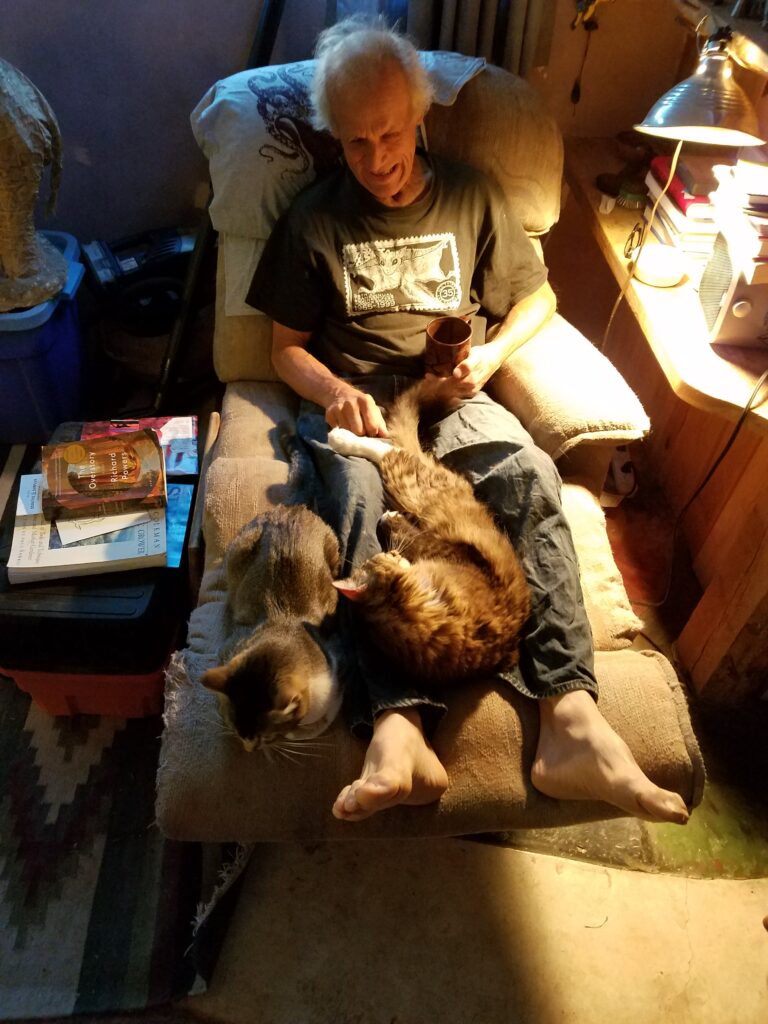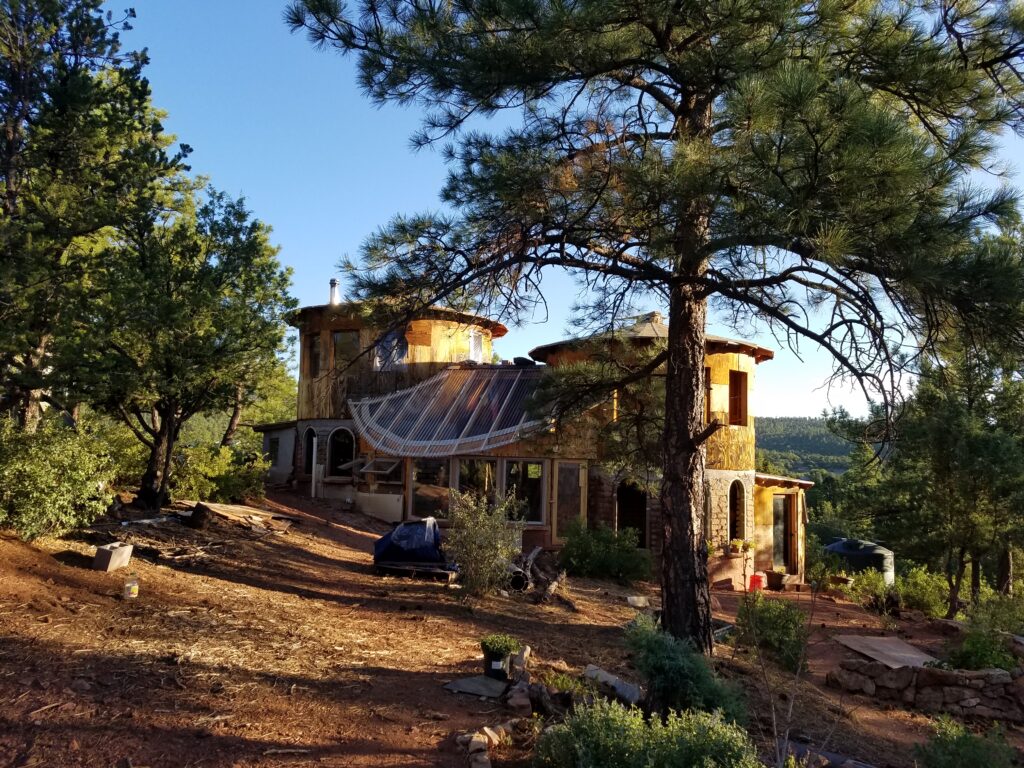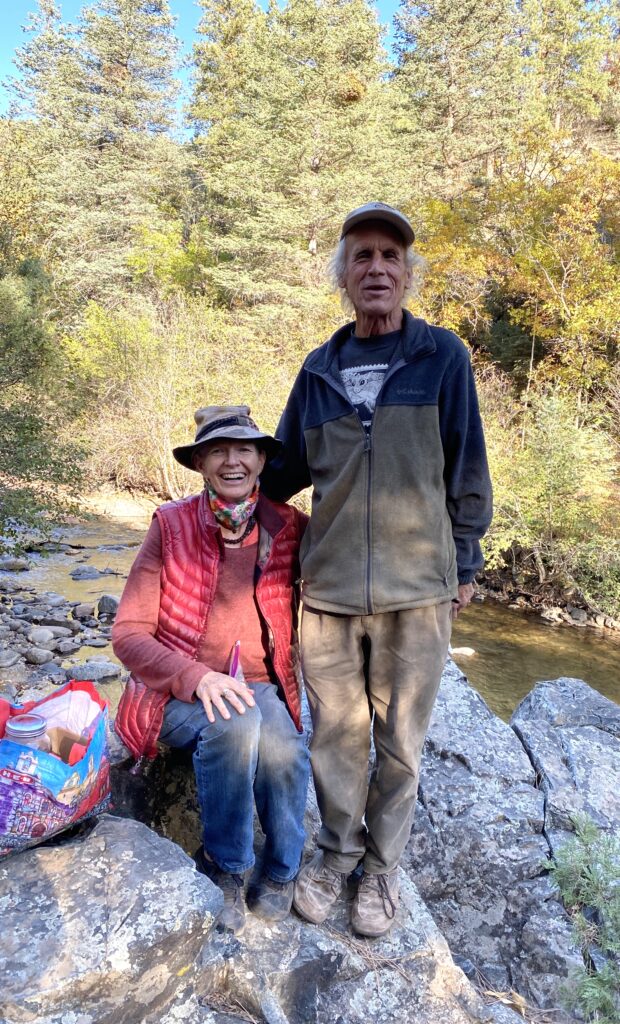
Cognitive Speech Therapy, Traumatic Brain Injury, and Kindness
The story
My husband Gord is a carpenter. He’s also a writer, builder, designer, an innovative human. A year ago this week he fell off a high ladder at work. He and his partner Matt were up on matching ladders, repairing an aging façade on a storefront in downtown Santa Fe. He broke a number of bones, including some in his skull. As he says, “I fell on my face.” And wrists and legs. It was early in the morning, a crisp day in February 2020. Acting fast, Matt got him immediately by ambulance to our local ER. Later that morning he was transferred to UNM Trauma Center, because as the ER doc on duty in Santa Fe said, “We don’t have a brain surgeon on today.” “Not that he’ll need brain surgery,” he hastened to add, “yet just in case.” At that point, cognitive speech therapy for brain injury was not on my mind; survival was.
It was a busy day at UNM Trauma admitting in Albuquerque. More than two dozen injured people were delivered, a whole ward’s worth. As the leading trauma center in the state, people came in from all over. The hospital struggled to find places for everyone that day. It was like being in a battle zone, very shocking. Gord was still unconscious; he’d sustained a concussion. To this day he does not remember the fall.
On the trauma ward
Ultimately we spent 8 days in the hospital’s trauma ward. We were on the edge of COVID-19, yet few people in the States knew that yet; we certainly didn’t. In the middle of the first night, before we’d even managed to secure a room for Gord, two skilled compassionate young women, medical residents, told us to ask for a bed chair, so we could stay in Gord’s room, when he did get a bed. We thought this was a great idea. Gord had had a traumatic hospitalization when young. We wanted to provide him with some safety buffer. The three of us, our daughter Iza, her man friend at the time, Jordan (who’s still a close family friend now), and I all took turns on the night shift. It was a surreal bardo, as you might imagine, Gord hooked up to all sorts of machines. There was one window to the outside, just behind the bed chair. The windowsill was cold enough we could keep food there.
Adam, Gord’s old friend (actually he’s much younger than Gord, yet their friendship goes way back) kindly brought us takeout food from Annapurna, the local Ayurvedic restaurant. (And later, enchiladas and a burger…) Gord was now conscious, feverish, and had two raccoon eyes; he’d lost his taste and smell with the head injury. He couldn’t see well; he had a headache. Ironically the headache disappeared when he stopped taking Tylenol. (“Tylenol gives me headaches,” he explained, once he could.)
Coming back into consciousness
Within days it was clear his consciousness had decided to stick around. He was asked multiple times per day his name and the date. Early on, he had no clue what day it was, yet he was clear about his name. At one point, 3 or 4 days into the hospital experience, a handsome Asian neurologist appeared in the room at dawn (you never knew when someone would show up). He was understated, sharp, with a good sense of humor. He began with the usual orientation questions. When he asked Gord his name, Gord looked at him and said, “Frank Smith.” The doc smiled and without a blink replied, “Well, I’m Joe….(with a pause) Joe Biden.” They got along famously after that.
Still, it wasn’t easy. Gord had many injuries; it took him days to be able to walk, though he remembers popping out of bed within a day of the accident. This wasn’t so.
We hoped he would be discharged to an inpatient rehab facility as the staff mentioned. Dealing with his multiple injuries and traumatic brain injury (TBI) in our tiny home didn’t seem realistic. Yet through a series of bureaucratic snafus, ultimately Gord was discharged home. Which, given the pandemic spreading unseen in the US at that point, was probably very fortunate.
He was discharged with two months each of cognitive speech therapy for brain injury, occupational therapy, and PT. The docs could see he would need the cognitive speech therapy for brain injury the most. They were concerned that if he got much PT early on, he would max out his treatment options and lose the cognitive speech therapy for brain injury he needed.
This was a realistic concern. He’d come back fully into his body and was now cruising the hospital corridors, tethered to one of us with a PT lead around his waist. Yet his brain had taken a terrible shock. It was hard to know how well he’d recover overall. A kind friend passed another brain-injured friend’s words of advice to us. “Give it a whole year. Let yourself rest. If you push it too fast too soon, you could become chronically impaired and depressed.”
Back at home
Gord had been chronically depressed before the accident for several years, dogged by early memories and how life could have been different. Many friends didn’t realize this, as he can be quite engaging. While at UNM, he was his cheery effervescent albeit brain-injured self with lots of hospital staff coming in and out for him to entertain. (Sagittarius, with Leo rising) Once safely home, installed in the recliner he’d spent months being depressed in when not working, the depressed stories and his patterns of coping with them returned. It was all terrible and hopeless, and now he was brain injured. Oh god. He couldn’t drive and he couldn’t work, two things he counted on to keep the demons away. His memory wasn’t good, and it had gotten worse, not surprisingly, since the fall. He was a bear. (His last name is, in fact, Bruen.)
Vital support
Yet there was all this therapy to show up for. He has lots of friends; we set up a “drive Gord to therapy” list with the help of our kind friend Galie. People drove the extra hour round trip to get to our home outside of Santa Fe to pick Gord up, take him to therapy in town, and return him safely. This was a miraculous win-win, especially for Gord. He had become isolated in his depression and previously mainly saw Matt at work. Now there were a variety of loving people to engage in wide-ranging conversations. This also let us, Iza and I, get back to work, at least part-time. Iza being home for the first half of this crucial year was such a blessing.
By mid-March 2020 the lockdown had happened in New Mexico and people could no longer safely drive Gord. We drove him to therapy to and from our work, and later he drove himself. This was a big deal, I didn’t want him to drive….and he really wanted to drive. There were compromises.
He got plenty of warm Easy Healing Drinks. He had gotten Pancha Karma for the first time the summer before the accident. All this helped together with food and supplements to support recovery.
Cognitive speech therapy for brain injury
Still, it was the cognitive speech therapy for brain injury that made a striking difference. His Medicare covered twice weekly visits with an aware, empathetic, and open speech-language pathologist (SLP) Karen. These visits were literally life saving. While Gord faithfully did his homework for her, picking out sequences of words and numbers on worksheets, ordering his life, he and Karen would also have long talks about life during his therapy with her. (With this kind of therapy I would say, it really helps to have a therapist who sees you for who you are.) More than once, it was recommended Gord see a counselor. He would say, “I have a therapist (Karen).” She helped him get his brain back, yet healthy heart, too.
Karen recommended Gord see an OT colleague of hers at the same local facility for his eyes. Initially, he hadn’t been able to read (and he’s an avid reader). Kathy the occupational therapist helped him recover visual skills. The young PTs gave him much useful wisdom about movement. Two bones had been broken in his right wrist, plus he had a deteriorating hip. I can only guess what it was like, when Gord chose to give himself those first showers at home on his own, navigating the cast on his wrist which had to be kept dry plus a funky hip and low patience levels with TBI – yet he did, with no complaint.
More vital support
He’d been advised to not return to work for at least three months. This was relieving to us as his family members; it seemed like the minimum. He was 69 with a variety of injuries. A close family friend had gifted us a lump sum while Gord was still in the hospital. This kindness had a vast impact. While there was lots to deal with, mentally and emotionally the stress of how to pay bills was covered. This was huge. Several other loved ones surprised us with generosity. Bless you John and Nancy, and Mom and Dodd. If we hadn’t had Medicare, help from friends, whatever savings we had, and the privileges associated with our skin color (we didn’t live in a food or health desert), our picture would have been much more grim.
Take your time, find realistic limits
Two months into the healing time, a systemically myopic orthopedic surgeon looked at Gord’s latest wrist Xray and told him in a telemedicine call “He could go back to work”. She was looking at his wrist not his brain. Gord had the wisdom to realize she was not right. For a workaholic person like himself, this was a giant breakthrough.
Am I sugar coating it? Yes. He was a bear. I often thought with empathy about the family members of retired brain injured athletes. It was frequently not a pretty picture. He was angry, would fly off the handle at the least frustration, freak out when he couldn’t find something. His fear of being brain damaged was huge, and a big trigger. He had little sense of others’ needs. In an early orientation at the local therapy center, he stepped in front of another older guy in line. The man was outraged, and rightfully so. Gord didn’t even see him, literally. Between his injured left eye and brain, the perception that the guy was there did not enter his consciousness. I apologized to the indignant patient and we moved on.
Healing from TBI is unpredictable. Iza and I re-read each handout as many times as we needed to, which was often. How to appropriately respond, what not to do. Healing from depression also holds a lot of mystery. One physician-researcher, Dr. Charles Raison, observed that in depression, certain parts of the brain can get overused; there is a beaten path to stories the person tells themselves over and over. In his work with hallucinogens, he saw other parts of the brain come online as depression alleviated. There can be fresh ways of looking at one’s life.
I think this happened for Gord. He was literally cracked open. He didn’t take any psychedelics, yet areas in his brain had to heal or die. He chose to live, which we’re really grateful for. (Plus, for the astrologers in the crowd, transitting Pluto hovering over his natal Mars finally moved on…)
Cognitive speech therapy for brain injury
If you or a loved one are working with a recent TBI, I’d say, give it a year. Get as much help as you possibly can, including cognitive speech therapy for brain injury. Open to help from unexpected sources; invite every resource you could possibly need, do not be shy. Gord now gets weekly yoga therapy by Zoom from our dear friend Manjula, which has been a next catalytic step in his healing. I’m incredibly grateful for all the kindness so many people have showed us. Thank you to everyone for your friendship, love, and unconditional acceptance. You know who you are!
Getting clear about cognitive speech therapy from an SLP
In this blog I’ve discussed cognitive speech therapy for brain injury from a speech-language pathologist. Another kind of therapy is called CBT, cognitive behavioral therapy. It is a valuable therapy positively associated with borderline personality disorder and bi-polar disorder. It has also been used to help relieve depression resulting from TBI. Yet this is not the therapy I’m advocating here; I am talking about cognitive speech therapy.
Help for the helpers
I kept my office for work, which became a refuge for both Iza and I, on different days. I wasn’t able to receive the monthly Polarity sessions I counted on to help me integrate my life and reality, because of the pandemic. So, instead I began counseling on Zoom with our dear friend Rich, a deep source of healing for me. Taking time in nature has also been a steady support for me.

Now
We celebrated Gord’s 70thbirthday last December with fellow Sagittarian newbie septuagenarian Blake and his partner Dominique. Gord is back to work on his own, smaller jobs. Less pressure. He and Matt are still in touch, yet each work on their own, in part due to the pandemic, yet also to give each other the space to discover the work rhythms they need as individuals now. Gord’s working on specific finishing details for the phantasmagoric home he designed for us twenty years ago in the woods (see above). It proceeds apace. Iza has catalyzed a lot of that progress in this past year, bless you, woman.

Gord’s clearer, more resilient, much less depressed than a year and a half ago. His taste and smell have not returned so far. When I cook for us, texture and appeal have become more important to consider. He has some new friends, in equally vulnerable exploring places in their lives, and many old friends. He lost some precious friends to death this past year, as well as one to unreconciled disagreement. He’s reading Sapiens as well as his favorite book about the Cambrian Ocean World. We can work together again. We give each other space and enjoy long walks and good food together, as much as we can. I’m grateful he made it. Here’s to however long all of us have in this life!

Amadea Morningstar, MA, RPE, RYT is a writer and an Ayurvedic and Polarity Therapy educator. There’s a new reading and writing group she will be guiding some time in the next few months. Like most things, it will be online on Zoom. We’ll meet weekly 5 – 6 times, working with Skill in Action by Michelle Cassandra Johnson. We’ll play with her processes together, and share our perspectives with one another. If you’d like to be kept in the loop on this new adventure, email me at amadea@newmexico.com.
Enjoy Amadea’s 5-hour video course on Polarity Therapy Energetic Nutrition here.
Easy Healing Drinks from the Wisdom of Ayurveda by Morningstar and Lynn comes in a 4-season full color print edition and also E-book formats. To learn more, click here.
